[English] 日本語
 Yorodumi
Yorodumi- PDB-1kv6: X-ray structure of the orphan nuclear receptor ERR3 ligand-bindin... -
+ Open data
Open data
- Basic information
Basic information
| Entry | Database: PDB / ID: 1kv6 | ||||||
|---|---|---|---|---|---|---|---|
| Title | X-ray structure of the orphan nuclear receptor ERR3 ligand-binding domain in the constitutively active conformation | ||||||
 Components Components |
| ||||||
 Keywords Keywords | GENE REGULATION / transcriptionally active conformation in absence of ligand / Structural Proteomics in Europe / SPINE / Structural Genomics | ||||||
| Function / homology |  Function and homology information Function and homology informationAF-2 domain binding / labyrinthine layer morphogenesis / positive regulation of transcription from RNA polymerase II promoter by galactose / regulation of thyroid hormone receptor signaling pathway / positive regulation of female receptivity / NR1H2 & NR1H3 regulate gene expression to control bile acid homeostasis / male mating behavior / hypothalamus development / nuclear steroid receptor activity / cellular response to Thyroglobulin triiodothyronine ...AF-2 domain binding / labyrinthine layer morphogenesis / positive regulation of transcription from RNA polymerase II promoter by galactose / regulation of thyroid hormone receptor signaling pathway / positive regulation of female receptivity / NR1H2 & NR1H3 regulate gene expression to control bile acid homeostasis / male mating behavior / hypothalamus development / nuclear steroid receptor activity / cellular response to Thyroglobulin triiodothyronine / Synthesis of bile acids and bile salts / progesterone receptor signaling pathway / estrogen response element binding / Synthesis of bile acids and bile salts via 27-hydroxycholesterol / Endogenous sterols / Synthesis of bile acids and bile salts via 7alpha-hydroxycholesterol / response to retinoic acid / estrous cycle / nuclear retinoid X receptor binding / histone acetyltransferase activity / cellular response to hormone stimulus / Recycling of bile acids and salts / Transcriptional regulation of brown and beige adipocyte differentiation by EBF2 / histone acetyltransferase / retinoic acid receptor signaling pathway / NR1H3 & NR1H2 regulate gene expression linked to cholesterol transport and efflux / estrogen receptor signaling pathway / lactation / steroid binding / : / positive regulation of adipose tissue development / Regulation of lipid metabolism by PPARalpha / peroxisome proliferator activated receptor signaling pathway / positive regulation of neuron differentiation / regulation of cellular response to insulin stimulus / BMAL1:CLOCK,NPAS2 activates circadian expression / SUMOylation of transcription cofactors / Activation of gene expression by SREBF (SREBP) / response to progesterone / cerebellum development / nuclear estrogen receptor binding / nuclear receptor binding / RNA polymerase II transcription regulatory region sequence-specific DNA binding / hippocampus development / mRNA transcription by RNA polymerase II / Heme signaling / Transcriptional activation of mitochondrial biogenesis / PPARA activates gene expression / Cytoprotection by HMOX1 / cerebral cortex development / Nuclear Receptor transcription pathway / Transcriptional regulation of white adipocyte differentiation / RNA polymerase II transcription regulator complex / male gonad development / nuclear receptor activity / sequence-specific double-stranded DNA binding / : / response to estradiol / positive regulation of cold-induced thermogenesis / HATs acetylate histones / MLL4 and MLL3 complexes regulate expression of PPARG target genes in adipogenesis and hepatic steatosis / DNA-binding transcription activator activity, RNA polymerase II-specific / transcription regulator complex / Estrogen-dependent gene expression / DNA-binding transcription factor activity, RNA polymerase II-specific / transcription coactivator activity / protein dimerization activity / positive regulation of apoptotic process / chromatin binding / regulation of DNA-templated transcription / regulation of transcription by RNA polymerase II / chromatin / positive regulation of DNA-templated transcription / protein-containing complex binding / positive regulation of transcription by RNA polymerase II / protein-containing complex / zinc ion binding / nucleoplasm / identical protein binding / nucleus / plasma membrane / cytosol Similarity search - Function | ||||||
| Biological species |  Homo sapiens (human) Homo sapiens (human) | ||||||
| Method |  X-RAY DIFFRACTION / X-RAY DIFFRACTION /  SYNCHROTRON / SYNCHROTRON /  MOLECULAR REPLACEMENT / Resolution: 2.7 Å MOLECULAR REPLACEMENT / Resolution: 2.7 Å | ||||||
 Authors Authors | Greschik, H. / Wurtz, J.-M. / Sanglier, S. / Bourguet, W. / van Dorsselaer, A. / Moras, D. / Renaud, J.-P. / Structural Proteomics in Europe (SPINE) | ||||||
 Citation Citation |  Journal: Mol.Cell / Year: 2002 Journal: Mol.Cell / Year: 2002Title: Structural and Functional Evidence for Ligand-Independent Transcriptional Activation by the Estrogen-Related Receptor 3 Authors: Greschik, H. / Wurtz, J.-M. / Sanglier, S. / Bourguet, W. / van Dorsselaer, A. / Moras, D. / Renaud, J.-P. #1:  Journal: Nature / Year: 1997 Journal: Nature / Year: 1997Title: Molecular basis of agonism and antagonism in the oestrogen receptor Authors: Brzozowski, A.M. / Pike, A.C. / Dauter, Z. / Hubbard, R.E. / Bonn, T. / Engstrom, O. / Ohman, L. / Greene, G.L. / Gustafsson, J.A. #2:  Journal: Cell(Cambridge,Mass.) / Year: 1998 Journal: Cell(Cambridge,Mass.) / Year: 1998Title: The structural basis of estrogen receptor/coactivator recognition and the antagonism of this interaction with tamoxifen Authors: Shiau, A.K. / Barstad, D. / Loria, P.M. / Cheng, L. / Agard, D.A. / Greene, G.L. #3:  Journal: Embo J. / Year: 2001 Journal: Embo J. / Year: 2001Title: X-ray structure of the orphan nuclear receptor RORbeta ligand-binding domain in the active conformation Authors: Stehlin, C. / Wurtz, J.M. / Steinmetz, A. / Greiner, E. / Schuele, R. / Moras, D. / Renaud, J.P. #4:  Journal: Cell.Mol.Life Sci. / Year: 2000 Journal: Cell.Mol.Life Sci. / Year: 2000Title: Structural studies on nuclear receptors Authors: Renaud, J.P. / Moras, D. | ||||||
| History |
|
- Structure visualization
Structure visualization
| Structure viewer | Molecule:  Molmil Molmil Jmol/JSmol Jmol/JSmol |
|---|
- Downloads & links
Downloads & links
- Download
Download
| PDBx/mmCIF format |  1kv6.cif.gz 1kv6.cif.gz | 103 KB | Display |  PDBx/mmCIF format PDBx/mmCIF format |
|---|---|---|---|---|
| PDB format |  pdb1kv6.ent.gz pdb1kv6.ent.gz | 79.5 KB | Display |  PDB format PDB format |
| PDBx/mmJSON format |  1kv6.json.gz 1kv6.json.gz | Tree view |  PDBx/mmJSON format PDBx/mmJSON format | |
| Others |  Other downloads Other downloads |
-Validation report
| Summary document |  1kv6_validation.pdf.gz 1kv6_validation.pdf.gz | 450.2 KB | Display |  wwPDB validaton report wwPDB validaton report |
|---|---|---|---|---|
| Full document |  1kv6_full_validation.pdf.gz 1kv6_full_validation.pdf.gz | 464.7 KB | Display | |
| Data in XML |  1kv6_validation.xml.gz 1kv6_validation.xml.gz | 19.8 KB | Display | |
| Data in CIF |  1kv6_validation.cif.gz 1kv6_validation.cif.gz | 26.5 KB | Display | |
| Arichive directory |  https://data.pdbj.org/pub/pdb/validation_reports/kv/1kv6 https://data.pdbj.org/pub/pdb/validation_reports/kv/1kv6 ftp://data.pdbj.org/pub/pdb/validation_reports/kv/1kv6 ftp://data.pdbj.org/pub/pdb/validation_reports/kv/1kv6 | HTTPS FTP |
-Related structure data
| Related structure data | 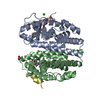 3erdS S: Starting model for refinement |
|---|---|
| Similar structure data | |
| Other databases |
- Links
Links
- Assembly
Assembly
| Deposited unit | 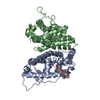
| ||||||||||
|---|---|---|---|---|---|---|---|---|---|---|---|
| 1 |
| ||||||||||
| Unit cell |
|
- Components
Components
| #1: Protein | Mass: 26084.373 Da / Num. of mol.: 2 / Fragment: ligand-binding domain Source method: isolated from a genetically manipulated source Details: complex with a SRC1 coactivator peptide in the absence of ligand Source: (gene. exp.)  Homo sapiens (human) / Gene: NR3B3 / Plasmid: pET-15b / Species (production host): Escherichia coli / Production host: Homo sapiens (human) / Gene: NR3B3 / Plasmid: pET-15b / Species (production host): Escherichia coli / Production host:  #2: Protein/peptide | Mass: 1776.072 Da / Num. of mol.: 2 / Fragment: second NR-box / Source method: obtained synthetically / Details: This sequence occurs naturally in humans / References: UniProt: Q13420, UniProt: Q15788*PLUS #3: Water | ChemComp-HOH / | |
|---|
-Experimental details
-Experiment
| Experiment | Method:  X-RAY DIFFRACTION / Number of used crystals: 1 X-RAY DIFFRACTION / Number of used crystals: 1 |
|---|
- Sample preparation
Sample preparation
| Crystal | Density Matthews: 4.04 Å3/Da / Density % sol: 69.3 % | ||||||||||||||||||||||||||||||
|---|---|---|---|---|---|---|---|---|---|---|---|---|---|---|---|---|---|---|---|---|---|---|---|---|---|---|---|---|---|---|---|
| Crystal grow | Temperature: 277 K / Method: vapor diffusion, hanging drop / pH: 8 Details: Tris.HCl, ammonium sulfate, glycerol, pH 8.0, VAPOR DIFFUSION, HANGING DROP at 277K | ||||||||||||||||||||||||||||||
| Crystal | *PLUS Density % sol: 60 % | ||||||||||||||||||||||||||||||
| Crystal grow | *PLUS Temperature: 4 ℃ | ||||||||||||||||||||||||||||||
| Components of the solutions | *PLUS
|
-Data collection
| Diffraction | Mean temperature: 130 K |
|---|---|
| Diffraction source | Source:  SYNCHROTRON / Site: SYNCHROTRON / Site:  ESRF ESRF  / Beamline: ID14-1 / Wavelength: 0.934 Å / Beamline: ID14-1 / Wavelength: 0.934 Å |
| Detector | Type: ADSC QUANTUM 4 / Detector: CCD / Date: Jan 27, 2001 / Details: diamond(111) monochromator, Ge(220) focusing |
| Radiation | Monochromator: diamond(111) / Protocol: SINGLE WAVELENGTH / Monochromatic (M) / Laue (L): M / Scattering type: x-ray |
| Radiation wavelength | Wavelength: 0.934 Å / Relative weight: 1 |
| Reflection | Resolution: 2.7→15 Å / Num. obs: 23306 / % possible obs: 96.7 % / Biso Wilson estimate: 71 Å2 / Rsym value: 0.049 |
| Reflection shell | Resolution: 2.7→2.81 Å / Num. unique all: 2587 / Rsym value: 0.148 / % possible all: 99.1 |
| Reflection | *PLUS Highest resolution: 2.7 Å / Lowest resolution: 15 Å / Rmerge(I) obs: 0.049 |
| Reflection shell | *PLUS Rmerge(I) obs: 0.148 |
- Processing
Processing
| Software |
| |||||||||||||||||||||||||
|---|---|---|---|---|---|---|---|---|---|---|---|---|---|---|---|---|---|---|---|---|---|---|---|---|---|---|
| Refinement | Method to determine structure:  MOLECULAR REPLACEMENT MOLECULAR REPLACEMENTStarting model: PBD ENTRY 3ERD Resolution: 2.7→15 Å / Isotropic thermal model: isotropic / Cross valid method: THROUGHOUT / σ(F): 0 / Stereochemistry target values: Engh & Huber
| |||||||||||||||||||||||||
| Refinement step | Cycle: LAST / Resolution: 2.7→15 Å
| |||||||||||||||||||||||||
| Refine LS restraints |
| |||||||||||||||||||||||||
| LS refinement shell | Resolution: 2.7→2.75 Å
| |||||||||||||||||||||||||
| Refinement | *PLUS Highest resolution: 2.7 Å / Lowest resolution: 15 Å / % reflection Rfree: 5 % / Rfactor Rfree: 0.267 / Rfactor Rwork: 0.233 | |||||||||||||||||||||||||
| Solvent computation | *PLUS | |||||||||||||||||||||||||
| Displacement parameters | *PLUS |
 Movie
Movie Controller
Controller


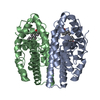

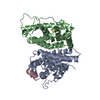
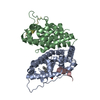

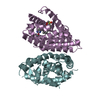

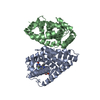



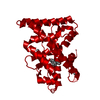
 PDBj
PDBj













